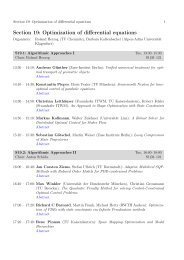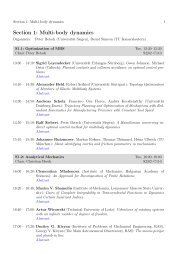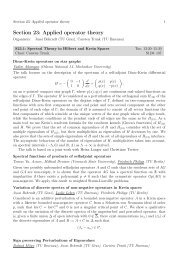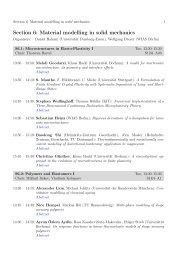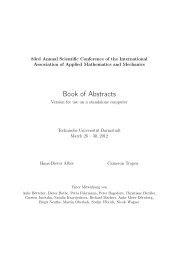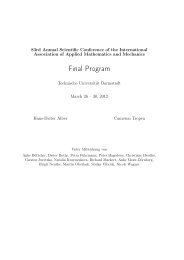Section 6: Material modelling in solid mechanics - GAMM 2012
Section 6: Material modelling in solid mechanics - GAMM 2012
Section 6: Material modelling in solid mechanics - GAMM 2012
You also want an ePaper? Increase the reach of your titles
YUMPU automatically turns print PDFs into web optimized ePapers that Google loves.
<strong>Section</strong> 6: <strong>Material</strong> <strong>modell<strong>in</strong>g</strong> <strong>in</strong> <strong>solid</strong> <strong>mechanics</strong> 25<br />
[1] S. SURESH, A. MORTENSEN, Fundamentals of functionally graded materials, Cambridge,<br />
The University Press, 1998.<br />
[2] Cz. WOZNIAK, B. MICHALAK, J. JEDRYSIAK (eds), Thermo<strong>mechanics</strong> of micro-heterogeneous<br />
<strong>solid</strong>s and structures. Tolerance averag<strong>in</strong>g approach, Wydawnictwo Politechniki Lodzkiej,<br />
Lodz, 2008.<br />
S6.10: Elasticity, Viscoelasticity, -plasticity III Thu, 13:30–15:30<br />
Chair: Daniel Balzani S1|01–A1<br />
Network evolution model: thermodynamics consistency, parameter identification and<br />
f<strong>in</strong>ite element implementation<br />
Vu Ngoc Khiêm, Roozbeh Dargazany, Mikhail Itskov (RWTH Aachen)<br />
In this contribution, the previously proposed network evolution model [1] for carbon black filled<br />
elastomers is further studied. First, we show that the model does not contradict the second law of<br />
thermodynamics and is thus thermodynamically consistent. On the basis of new experimental data<br />
the <strong>in</strong>fluence of filler concentration on the material parameters is further exam<strong>in</strong>ed. Accord<strong>in</strong>gly,<br />
this <strong>in</strong>fluence concerns only three material parameters and is approximated by phenomenological<br />
relations. These relations enable one to simulate rubbers based on the same compound with<br />
various filler concentrations. F<strong>in</strong>ally, the model is implemented to the FE-Software ABAQUS and<br />
illustrated by a number of numerical examples. The examples demonstrate good agreement with<br />
experimental results with respect to the Mull<strong>in</strong>s-Effect, permanent set and <strong>in</strong>duced anisotropy.<br />
[1] R. Dargazany and M. Itskov, A network evolution model for the anisotropic Mull<strong>in</strong>s effect<br />
<strong>in</strong> carbon black filled rubbers, International Journal of Solids and Structures 46 (2009),<br />
2967–2977.<br />
Shakedown analysis of periodic composites with k<strong>in</strong>ematic harden<strong>in</strong>g material model<br />
M<strong>in</strong> Chen, A. Hachemi, D. Weichert (RWTH Aachen)<br />
Lower-bound limit and shakedown analysis of periodic composites with the consideration of k<strong>in</strong>ematic<br />
harden<strong>in</strong>g are <strong>in</strong>vestigated on the representative volume element. With the comb<strong>in</strong>ation of<br />
homogenization theory, the homogenized macroscopic admissible load<strong>in</strong>g doma<strong>in</strong>s are evaluated.<br />
Furthermore, the strengths of periodic composites of elastic-perfectly plastic, unlimited and l<strong>in</strong>ear<br />
limited k<strong>in</strong>ematic harden<strong>in</strong>g material models are calculated and compared <strong>in</strong> this paper.<br />
Theory of mixture based material model<strong>in</strong>g - An <strong>in</strong>elastic material model for a 12%chromium<br />
steel<br />
Andreas Kutschke, Konstant<strong>in</strong> Naumenko, Holm Altenbach (Universität Magdeburg)<br />
Components composed of advanced heat resistant steels face a complex load<strong>in</strong>g of mechanical and<br />
thermal stresses under cyclic and long-term conditions. Additionally, a failure of these components<br />
usually has serious outcome, because of the extreme work<strong>in</strong>g conditions. From this follows the<br />
need of a reliable material model for the construction process.<br />
Classical technical guidel<strong>in</strong>es are historically grown and the experience of eng<strong>in</strong>eers contributed<br />
to their development, but it turns out that these classical guidel<strong>in</strong>es face their limit of use. Recently<br />
more sophisticated material models are developed to reach the real limit of the materials and to<br />
predict their behavior with more accuracy.



